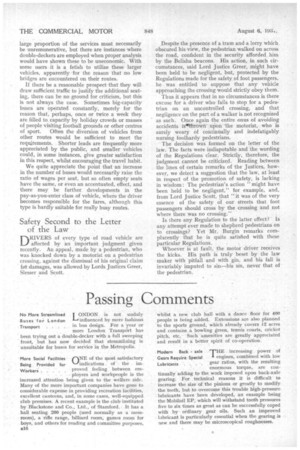Passenger Transport as a Science
Page 21

Page 22

If you've noticed an error in this article please click here to report it so we can fix it.
MANY operators, both large and small, of road passenger-transport fleets pride themselves upon their great knowledge of public requirements and the way in which they should cater for these. In some cases extensive and analytical statistics of operating costs, traffic receipts, etc., are compiled; yet how many go sufficiently far with these? The essential factors, from the point of view of profitable returns, are the cOst and receipts per seat, and it is surprising how much these can vary according to the class of vehicle employed, i.e., double or single-decker, the fuel and the influence of vehicle weight.
It is obvious that in the majority of big fleets a • 131.5 large proportion of the services must necessarily be unremunerative, but there are instances where double-deckers are employed when proper analysis would have shown these to be uneconomic. With some users it is a fetish to utilize these larger vehicles, apparently -for the reason that no low bridges are encountered on their routes. If there be a reasonable prospect that they will draw sufficient traffic to justify the additional seating, there can be no ground for criticism, but this is not always the case. Sometimes big-capacity buses are operated constantly, merely for the reason that, perhaps, once or twice a week they are filled to capacity by holiday crowds or masses of people visiting football groprids or other centres of sport. Often the diversion of vehicles from other routes would be sufficient to meet the requirements. Shorter leads are frequently more appreciated by the public, and smaller vehicles could, in some instances, give greater satisfaction in this respect, whilst encouraging the travel habit. We quite appreciate the point that an increase in the number of buses would necessarily raise the ratio of wages per seat, but so often empty seats have the same, or even an accentuated, effect, and there may be further developments in the pay-as-you-enter class of vehicle, where the driver becomes responsible for the fares, although this type is hardly suitable for really busy routes.
Safety Second to the Letter of the Law DRIVERS of every type of road vehicle are affected by an important judgment given recently. An appeal, made by a pedestrian, who was knocked down by a motorist on a pedestrian crossing, against the dismissal of his original claim tot damages, was allowed by Lords Justices Greer, Slesser and Scott. Despite the presence of a tram and a lorry which obscured his view, the pedestrian walked on across the road, confident in the security afforded him by the Belisha beacons. His action, in such circumstances, said Lord Justice Greer, might have been held to be negligent, but, protected by the Regulations made for the safety of foot passengers, he was entitled• to suppose that any vehicle approaching the crossing would strictly obey them. Thus it appears that in no circumstances is there excuse for a driver who fails to stop for a pedestrian on an uncontrolled crossing, and that negligence on the part of a walker is not recognized as such. Once again the entire onus of avoiding accidents is4throWil upon the motorist, who is surely weary of continually and indefatigably nursing foolhardy pedestrians. The decision was formed on the letter of the Jaw. The facts were indisputable and the wording of the Regulations clear. Strictly, therefore, the judgment cannot be criticized. Reading between the lines of certain remarks of the Justices, however, we detect a suggestion that the law, at least in respect of the promotion of safety, is lacking in wisdom: The pedestrian's action "might have been held to be negligent," for example, and, from Lord Justice Scott, that " it was of the very essence of the safety of our streets that foot passengers should cross by the crossing and not where there was no crossing." Is there any Regulation to the latter effect? Is any attempt ever made to shepherd pedestrians on to crossings? Yet Mr. Burgin remarks complacently that he is quite satisfied with these particular Regulations. Whoever is at fault, the motor driver receives the kicks. His path is truly beset by the law maker with pitfall and with gin, and his fall is invariably imputed to sin—his sin, never that of the pedestrian.












































































